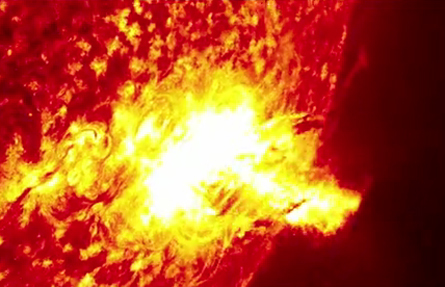Atom & Cosmos
A solar sneeze, a superhot planet, the death of a comet and more in this week’s news
Sun snot
Someone should teach the Sun some manners. When it sneezed on June 7, the sun blew an enormous glob of dark plasma into space — and NASA’s Solar Dynamics Observatory caught it on tape. The 20,000-degree Celsius eruption — actually rather chilly by solar standards — can be seen raining back onto the sun’s surface in blobs and streamers. Some of the material made a beeline for sunspots hundreds of thousands of kilometers from the eruption site. Scientists say an unstable magnetic filament triggered the eruption, which sent shock waves halfway around the star and blew around 4 trillion kilograms of charged particles away from the sun — one of the largest events of its type measured so far. Gesundheit. —Nadia Drake

Death of a comet
Scientists have watched plenty of comets come close to the sun and then vanish, but witnessing the actual destruction is tough, John Brown of the University of Glasgow in Scotland and colleagues report online July 10 at arXiv.org. The team’s new calculations suggest that lightweight comets explode high above the sun; only comets with nuclei heavier than about 100 billion metric tons manage to reach the surface to die. The scientists are hoping to catch a comet in the act with the Solar Dynamics Observatory satellite. —Alexandra Witze
Hottest known planet
Welcome to Hades, a.k.a. WASP-33b. Astronomers have identified this planet, which orbits a star in the constellation Andromeda, as the hottest known. Its surface is a scalding 3,350 degrees Celsius, thanks to the inherent heat of its parent star and the fact that the planet is so close to it, orbiting just once every 1.22 days. A team led by Alexis Smith of Keele University in England reported the finding online July 8 in the Monthly Notices of the Royal Astronomical Society. —Alexandra Witze
Galactic menopause
Both the Milky Way and its neighbor, the Andromeda galaxy, could be in the midst of a midlife crisis. Astronomers have used computer models and galaxy surveys to assess how far the two galaxies have come in their life cycle, as measured by the color of their stars. Both appear to be roughly halfway between young blue stars and red older stars, a team from Swinburne University of Technology in Hawthorn, Australia report in the August 1 Astrophysical Journal. Scientists may thus be able to examine an important galactic life change as it happens.—Alexandra Witze







